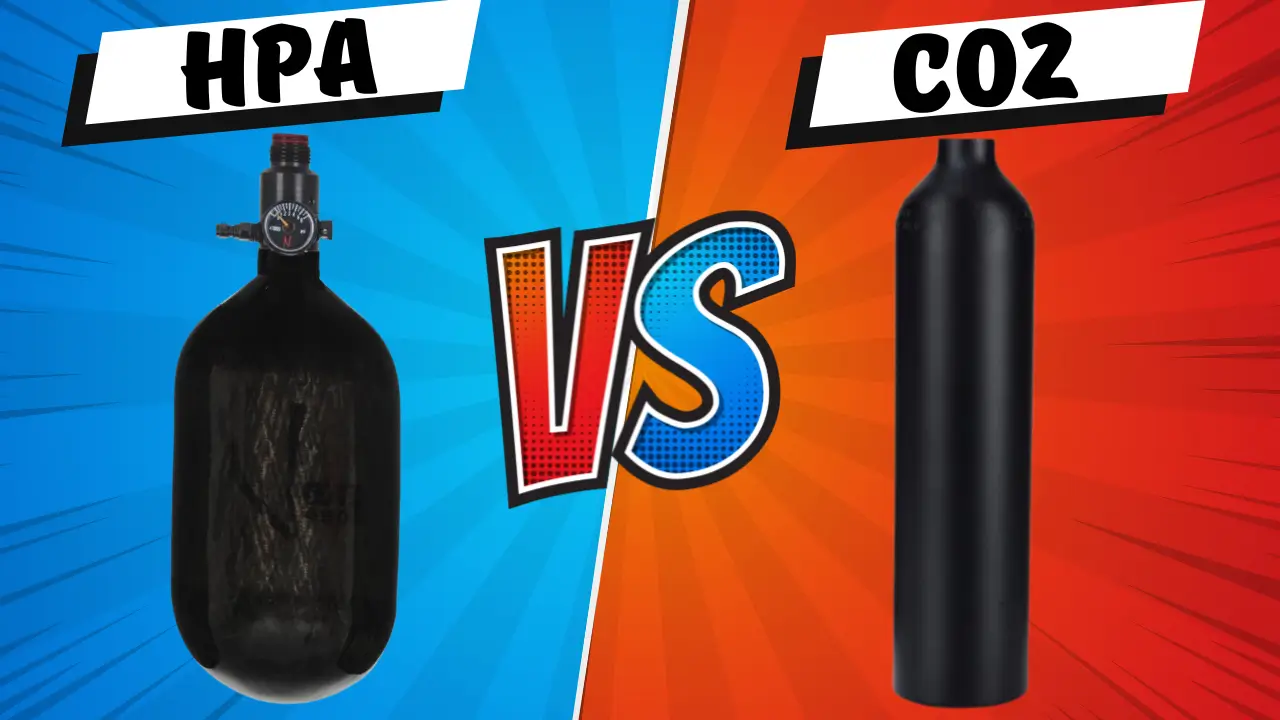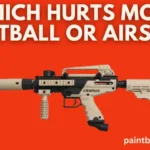Airsoft has gained popularity as an exhilarating sport, where players engage in simulated combat using replica firearms that shoot non-lethal pellets. Choosing the right air system for your airsoft gun is crucial for optimizing performance and enhancing your gameplay experience.
In this article, we will focus on the two main air systems used in airsoft: HPA (High-Pressure Air) and CO2, decoding their functionalities, advantages, and limitations.
Understanding HPA (High-Pressure Air) Systems:
What is HPA and how does it work?

HPA systems utilize compressed air stored in a portable tank to power airsoft guns. These tanks are typically filled with air at pressures ranging from 3000 to 4500 PSI.
When the trigger is squeezed, the compressed air is released, propelling the BB pellets with force and accuracy.
Advantages of using HPA systems:
- Consistent velocity and accuracy: HPA systems provide unparalleled precision with consistent muzzle velocity, ensuring your shots hit the target precisely where you aim.
- Customizable performance: With HPA systems, you can fine-tune various aspects of your airsoft gun’s performance, such as adjusting muzzle velocity and rate of fire, to suit your specific preferences.
- Higher capacity and efficiency: HPA tanks generally hold a larger volume of air compared to CO2 canisters, resulting in extended gameplay before needing to refill.
Limitations of HPA systems:
- Initial cost and setup requirements: HPA systems often come with a higher upfront cost, including the purchase of a tank and necessary accessories like regulators and lines. Additionally, setting up an HPA system may be more complex than using CO2.
- Additional maintenance: HPA systems require periodic maintenance, including tank inspections, regulator servicing, and preventative measures to ensure optimal performance and longevity.
- Limited mobility: The tethered setup of HPA systems, where the air tank is physically attached to the gun, can restrict your mobility during intense gameplay situations, hindering swift movements and agility.
Exploring CO2 Systems:
What is CO2 and how does it work?

CO2 systems utilize small, disposable cartridges filled with carbon dioxide gas. These cartridges are inserted into the airsoft gun’s magazine or stock and are punctured when the trigger is pulled, releasing the gas to propel the pellets.
Benefits of using CO2 systems:
- Lower initial cost and setup: CO2 systems typically have a more affordable upfront cost compared to HPA systems, making them a popular choice for beginners or players on a budget. The simplicity of the setup also makes CO2 systems easier to use.
- Portability and ease of use: CO2 cartridges are compact and lightweight, allowing for easy maneuverability during gameplay. The simplicity of the CO2 system means minimal setup and no need for external air tanks or lines.
- Suitable for warmer climates: CO2 performs better in higher temperatures, making it an ideal choice for players in warmer climates, where HPA systems may experience performance issues due to increased air expansion.
Drawbacks of CO2 systems:
- Inconsistent velocity and accuracy: CO2 systems are susceptible to fluctuations in muzzle velocity, leading to decreased accuracy and a need to compensate for these variations during gameplay.
- Limited customization options: Unlike HPA systems, CO2 systems offer limited adjustability, restricting players from fine-tuning their airsoft gun’s performance to their desired specifications.
- Lower efficiency and capacity: CO2 cartridges have a limited capacity compared to HPA tanks, leading to more frequent cartridge changes during gameplay and potentially disrupting the flow of the game.
HPA vs CO2 Comparing Performance and Accuracy:
Velocity consistency:
- HPA’s consistent velocity: HPA systems excel in maintaining a consistent muzzle velocity shot after shot, allowing players to accurately gauge the trajectory of their shots and make necessary adjustments.
- CO2’s fluctuating velocity: Due to the nature of CO2 gas expansion, the muzzle velocity tends to fluctuate, resulting in variations in shot performance and decreased accuracy.
Accuracy considerations:
- HPA’s precision control: With HPA systems, players have greater control over their airsoft gun’s accuracy, enabling them to fine-tune their shots for enhanced precision and a higher chance of hitting their targets.
- CO2’s potential for inconsistency: CO2 systems, with their inherent velocity fluctuations, pose a challenge to achieving consistent accuracy, requiring players to adapt their aiming techniques and compensate for these inconsistencies.
Customization Options:
Adjusting velocity:
- HPA’s adjustable regulators: HPA systems offer the flexibility of adjusting the regulator, allowing players to fine-tune the muzzle velocity of their airsoft gun to conform to field regulations or personal preferences.
- CO2’s limited adjustability: Unlike HPA, CO2 systems have limited adjustability options, leaving players with fewer choices for modifying their airsoft gun’s velocity.
Upgrading internals:
- HPA’s compatibility with aftermarket parts: HPA systems have a wider range of aftermarket parts available, enabling players to upgrade and customize various components of their airsoft guns for improved performance and precision.
- CO2’s limited upgrade potential: CO2 systems have relatively fewer upgrade options, primarily due to the constraints of the gas system, limiting players’ ability to enhance their airsoft gun’s internals.
Practical Considerations:
Air capacity and refilling methods:
- HPA tank capacity and refilling options: HPA tanks typically have a larger air capacity, allowing for extended gameplay before needing a refill. Refilling options include scuba tanks, compressors, or refill stations available at airsoft fields.
- CO2 cartridges and their limitations: CO2 cartridges, being smaller and disposable, have limited gas capacity, leading to more frequent cartridge changes during gameplay. Refilling CO2 cartridges necessitates the purchase of new cartridges or using refillable CO2 canisters.
Maintenance requirements:
- HPA system upkeep: HPA systems require periodic inspections, regulator maintenance, and the replacement of worn-out components to ensure optimal performance and avoid any safety hazards.
- CO2 system maintenance: CO2 systems generally have fewer maintenance requirements, primarily involving the replacement of CO2 cartridges and occasional cleaning of the airsoft gun to remove debris or residue.
Mobility and Game Scenarios
HPA’s impact on mobility:
- Tethered setup and limitations: HPA systems, with their physical attachment of the air tank to the airsoft gun, can restrict player mobility, especially during fast-paced or close-quarter battles. The need to manage the airline and tank position adds an extra element to consider during gameplay.
- Remote line options for increased mobility: Players using HPA systems can opt for remote lines, which connect the air tank to the gun via a flexible hose. This provides increased flexibility and freedom of movement, minimizing the limitations posed by the tethered setup.
CO2’s advantages for certain game scenarios:
- Simplicity for close-quarter battles: CO2 systems, with their ease of use and minimal setup requirements, prove advantageous for close-quarter battles where quick reaction times and agility are paramount.
- Enhanced maneuverability: The lightweight and portable nature of CO2 systems allow players greater maneuverability, making them well-suited for dynamic game scenarios that require swift movements and rapid changes in position.
Choosing the Right System for Your Playstyle
Determining playstyle preferences
Before deciding between HPA and CO2 systems, it is essential to assess your individual playstyle, considering factors such as aggression level, preferred game scenarios, and personal preferences regarding precision and customization.
Factors to consider
- Competitive versus casual play: If you are a competitive player aiming for maximum accuracy and consistency, HPA systems may better suit your needs. However, for casual play or entry-level engagement, CO2’s lower initial cost and simplicity may be a more practical choice.
- Field regulations: Familiarize yourself with the field regulations regarding air systems, as certain fields may have restrictions or requirements that influence your decision.
- Budget constraints: Consider your budget and weigh the initial cost, ongoing maintenance, and refill expenses associated with both HPA and CO2 systems to ensure it aligns with your financial limitations.
- Desired level of performance: Evaluate whether the higher level of performance and customization options offered by HPA systems outweigh the potential drawbacks, or if the simplicity and portability of CO2 systems suffice for your gameplay objectives.
Conclusion
In summary, the choice between HPA and CO2 air systems for your airsoft game relies on carefully considering various factors: the level of customization and precision desired, initial cost and ongoing expenses, field regulations, as well as the practicality and convenience needed for your specific playstyle.
Understanding the advantages and limitations of both HPA and CO2 systems will allow you to make an informed decision that enhances your gameplay experience and helps you dominate the airsoft arena.
FAQs (Frequently Asked Questions)
Can HPA systems be used with CO2-powered airsoft guns?
No, HPA systems cannot be used with CO2-powered airsoft guns as they require different mechanisms for operation
Can CO2 systems be converted to HPA?
Yes, CO2 systems can be converted to HPA, but it may require modifications and additional equipment.
Is CO2 more environmentally friendly than HPA?
Neither CO2 nor HPA can be considered inherently more environmentally friendly as both have different impacts and considerations.
Are HPA systems more expensive to maintain?
HPA systems are generally more expensive to maintain due to the need for specialized equipment and regular servicing.
How often should CO2 cartridges be replaced?
CO2 cartridges should be replaced as per the manufacturer’s instructions, but typically it’s recommended to replace them after each use or within a few days.



